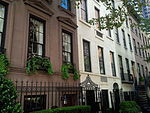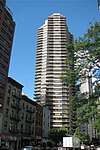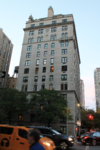Barbizon 63
1927 establishments in New York CityClubhouses in ManhattanGothic Revival architecture in New York CityHotel buildings completed in 1927Hotel buildings on the National Register of Historic Places in Manhattan ... and 6 more
Hotels established in 1927Lexington AvenueNew York City Designated Landmarks in ManhattanResidential buildings on the National Register of Historic Places in ManhattanUpper East SideYWCA buildings

The Barbizon (known since 2005 as Barbizon 63), is a building located at 140 East 63rd Street on the Upper East Side of Manhattan, New York City. It was for many decades a female-only residential hotel for young women who came to New York City for professional opportunities, but still wanted a "safe retreat" that felt like the family home.The Barbizon was added to the National Register of Historic Places in 1982, and was designated a city landmark by the New York City Landmarks Preservation Commission in 2012.
Excerpt from the Wikipedia article Barbizon 63 (License: CC BY-SA 3.0, Authors, Images).Barbizon 63
East 63rd Street, New York Manhattan
Geographical coordinates (GPS) Address Nearby Places Show on map
Geographical coordinates (GPS)
| Latitude | Longitude |
|---|---|
| N 40.764722222222 ° | E -73.966111111111 ° |
Address
East 63rd Street 139
10021 New York, Manhattan
New York, United States
Open on Google Maps




